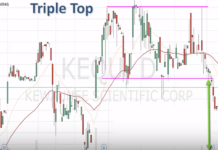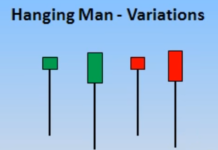The flag pattern is one of the most noteworthy trading patterns when talking about the tools which are used in technical analysis. It predicts the continuation of the existing market trend, most often occurring after a significant price movement.
Before reading the article and writing your questions in the comments section, I recommend to watch this video. It’s not long but covers the biggest part of questions on the topic.
What does the Flag look like? Like its real counterpart, it consists of two parts — “flagpole” and “cloth”. The first is a steep line of the preceding trend, and the second is the corridor within which the price moves (Picture 1). The price pushed lower in the first phase, then created a consolidation zone – “cloth” – and then continued lower.

We’ll note the Flag pattern can often be found on the charts and almost regardless of the selected time interval. You will find it on five-minute charts as well as weekly timeframes.
What is the Flag Pattern?

First of all, it should be noted the pattern forms immediately after the moment the trend is coming to the end. Such moments are characterized by consolidation and even a slight correction to the trend line, which is a prerequisite for the trend continuation.
Another Flag’s feature is the presence of two lines parallel to each other or slightly converging. Most often they have a slope in the direction that is opposite to the trend, which often confuses traders (Picture 2). Pay attention to the fact that it is extremely important to determine both lines in time and wait for the quotation to break.

Also, we should talk about the «flagpole» — the pattern’s mandatory element. As it was mentioned above, it shows the high impulsivity of the trend which preceded the resulting «cloth» of the Flag.
Also, the following points are typical for the current pattern:
- Most often the Flag appears in the middle of the trend movement. As a result, after the price breakthrough, it’s necessary to go through the same distance as before this pattern formation.
- The Flag can arise in case of both an upward trend and a downtrend (and may be called a bullish or bearish one).
- «Flagpole» should rise sharply, and its length should be approximately two widths of the «cloth» base.
- The Flag is a fairly strong and stable pattern, for which the trend fracture is uncommon (occur very rarely).

How to trade a flag?
Now it’s time to show the way to apply the Flag in practice — in the real exchange trading process. Since we have a bearish flag example, let’s do a breakdown of the trade to elements to better understand this formation. Everything also applies for a bullish flag — just place the orders in the other direction (Picture 3).

- determine the moment of breakdown of the cloth’s lower trend line (towards the original trend);
- In the moment when the candlestick closes below the cloth, open a short trade;
- Find the minimum of the trend line (the lowest point) and set the stop-loss slightly above it;
- Determine the place for the take-profit installation — equal to the distance of the flagpole in the initial trend
Conclusion
Finally, we need just to list the key points which you will learn after reading this material — for better understanding them. Briefly, the Flag is a pattern that provides the opportunity to enter the market in a situation when the trend is in a paused state and the price is slightly adjusted against the initial trend. Flag provides an opportunity to open positions at a much more suitable price, rather than before it broke the cloth. The pattern we discuss can be of two varieties — bearish and bullish.






Thank you so much. Your tutorial are simple yet powerful, Thanks for cutting to the chase with only the facts.
What time frame do you trade sir?
A quick question sir…. the difference between a flag and a channel is just how long has the pattern lasted?
Thank you sir, I find this interesting and fan…. but as a beginner i just want to know is there any specific rules like lower highs or lower lows or higher highs and higher lows etc about formation of pennant or flag pattern???
nice & concise ! clearly explained and most helpful! 😉
Can this be applicable in shorter time frames
You’re welcome. Keep in mind that the whole reason a pattern usually works is because so many people see it that they then are able to “make” it work so to speak.
There are times where seeing some of these patterns requires a lot of imagination. And very good at imagining
There are times where seeing some of these patterns requires a lot of imagination. And very good at imagining
Thank you